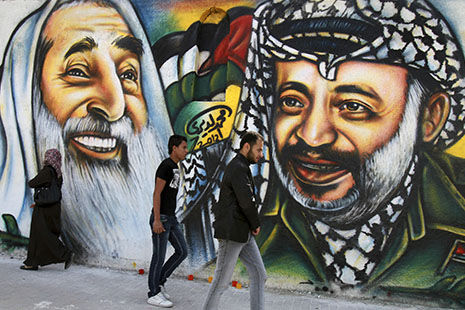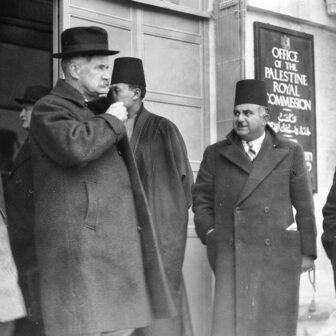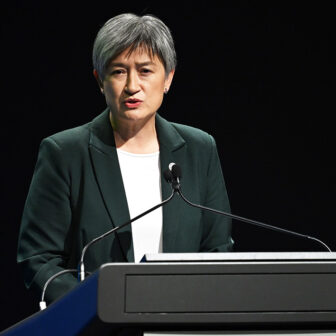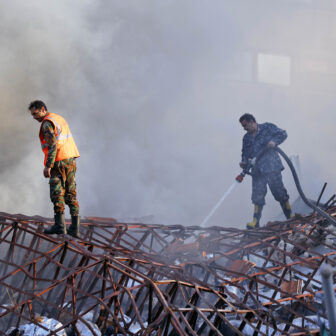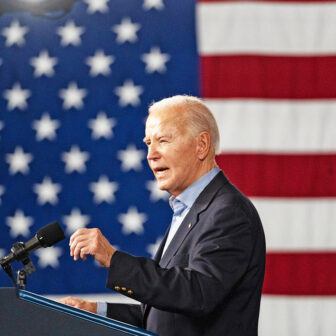THIS month’s outbreak of violence in Gaza sent thousands of Israelis into bomb-shelters and left twenty-five Palestinian militants and civilians dead. While Hamas forces in Gaza did not participate in the exchange of fire, the movement failed to rein in competing militants. Groups affiliated to the Popular Resistance Committees responded to the assassination of one of its leaders by the Israeli military with a barrage of rockets and mortars, and within hours the situation escalated. For now, it seems that Egyptian mediation has re-established a fragile ceasefire.
While Hamas’s decision not to return fire is certainly a welcome development, the internal political struggle over how the movement should position itself in relation to Israel is far from over.
As Israeli planes circled the skies of Gaza, representatives of different wings of Hamas embarked on two competing diplomatic missions. Khaled Meshal, head of Hamas political bureau and overall leader of the movement, paid a surprise visit to the Turkish capital, Ankara, a fortnight ago, briefing Turkey’s prime minister, Recep Tayyip Erdogan, on what was described as “recent developments in Palestinian politics” and the prospects for reconciliation between the competing Palestinian factions, Hamas and Fatah.
Meanwhile, the Gaza-based leaders of Hamas dispatched strongman Mahmoud Zahhar to Tehran. Zahhar, one of the closest aides of Ismael Haniyeh, the Gaza prime minister, thanked Iran for its “unlimited and unconditional support.” Zahhar also underlined the fact that the “principles and strategies of Hamas” – synonymous with the movement’s commitment to armed struggle and terror operations – had “not changed” despite the ceasefire.
Both diplomatic initiatives are clear attempts to rally support behind competing wings of Hamas. As such, they are only the most recent examples of a series of regional moves in the past few weeks that illustrate growing tensions within the organisation, as separate centres of power vie to determine the future course of the movement.
The contenders are the leadership in Gaza, represented by Haniyeh and his interior Minister Fathi Hammad, and the exiled overall leadership represented by Meshal. While Haniyeh maintains control of a breakaway branch of the Palestinian Authority in the Gaza strip, Meshal is supported, by and large, by Hamas members from the West Bank and the Palestinian Diaspora, though he also enjoys the backing of many Gazans critical of Haniyeh’s authoritarian regime in the coastal strip.
Early assessments assume that the struggle centres on the implementation of reconciliation documents signed by Meshal and the Palestinian President Mahmoud Abbas, who is leader of Fatah. Agreements were ceremoniously concluded in Cairo in May 2011 and again in Doha in February 2012. Both agreements were welcomed by many Palestinians but were concluded in the face of ill-concealed opposition by Haniyeh’s Gaza branch.
The Gaza prime minister, fearing a challenge to his position in the coastal strip, attempted to torpedo the initial Cairo agreement by praising the “martyr Osama bin Laden” on the eve of the concluding ceremony. Likewise, the Gaza leadership opposed the Doha agreement by labelling it “unconstitutional” and by refusing to accept President Abbas as an interim acting prime minister, as stipulated in Doha.
The question of who will lead the interim Palestinian government until elections are held is still far from concluded. But there is clearly more at stake than personal ambition. What lies at the core of the conflict between the Hamas leaders in Gaza and the leadership abroad is a fundamental struggle over the future of Hamas as a movement. Certainly, recent shifts within Hamas suggest the possibility of a transformation from terrorist organization to legitimate political party. While the outcome remains unpredictable, signs of internal strife have escalated to a tipping point.
In December, Ismael Haniyeh embarked on a western-bound Mediterranean tour in an attempt to gather political support from post-revolutionary regimes in Tunisia and Egypt. He was granted a hero’s welcome. In mid-February, he started a second diplomatic circuit that brought him to Qatar, Bahrain and Iran. To the dismay of more conciliatory Hamas members, Haniyeh vehemently and repeatedly stressed Hamas’s commitment to “armed resistance,” “the futility of peace negotiations” and the movement’s commitment to fight “until all Palestinian land has been liberated.” Haniyeh’s hosts in Tehran reacted warmly, swiftly increasing the flow of financial support to Gaza.
Emboldened by this wave of outside recognition, Haniyeh has continued to lobby against the implementation of the reconciliation agreements. By preventing the Palestinian Central Election Commission from updating voter registers, he is effectively preventing elections that were scheduled in the Cairo and Doha agreements in order to cement his hold to power.
Haniyeh’s regional rallying of support has not gone unnoticed by Khaled Meshal. In contrast to the Gaza prime minister, Meshal silently backed “exploratory talks” between Israeli and Palestinian negotiators hosted by the King of Jordan in Amman in January. Likewise, Meshal has on numerous occasions expressed his acceptance of a Palestinian State in the West Bank and the Gaza Strip – a tacit acceptance by the faction of the right of the State of Israel to exist in secure borders side by side with a future Palestinian state.
At the same time, Meshal has attempted to bring Hamas closer to the secular institutions of Palestinian political life as he pushes for the organisation’s integration into the Palestine Liberation Organization, which at the moment does not include the movement. Integrating Hamas into the PLO would close Palestinian ranks and effectively mean a formal cessation of violence from Hamas. At the same time, it would represent a further implied acceptance by Hamas of agreements previously signed between the PLO and Israel.
Meshal’s change of heart can be partly attributed to the ongoing public revolt against Syrian President Bashar a-Assad, who has hosted Hamas’s diaspora leadership since the 1990s. Assad’s violent response to an uprising that is at least partly backed by Hamas’s umbrella organisation, the Muslim Brotherhood, has strained relations. Reacting to turmoil in Syria, Meshal has been forced to relocate Hamas’s diaspora headquarters from Damascus to Doha, the Qatari capital, in February. This relocation from Iran-backed Damascus to Washington’s closest remaining Arab ally in the region is an important symbolic gesture towards what Meshal may very well envisage for the movement: a comprehensive re-invention of Hamas.
Whether or not Hamas as a unified movement would follow Meshal on this change of course has been the subject of much speculation. Notably, Meshal recently expressed his outrage at Gaza’s refusal to fall “in line” by announcing he would step down as leader of the political bureau. Elections for the Hamas Shoura Council, the group’s highest decision-making authority, which appoints the movement’s leader, are due in April. It is unclear whether Meshal will ultimately follow through on this threat, as observers speculate that he could be re-elected despite his recent declaration. Alternatively, it seems he might be elected to head a new and independent Palestinian chapter of the Muslim Brotherhood.
The outcome of this power struggle within Hamas is far from pre-determined. Current developments present Western decision-makers with an opportunity to influence the outcome and to support the shift from a renegade terrorist militia to a necessary partner in what could very well be an all-encompassing peace process with Israel.
Hamas leaders such as Khaled Meshal need to be engaged not isolated. Washington has embraced moderate Islamists in Cairo and Tunis, and representatives of political Islam in the Palestinian territories should not be treated any differently. Instead of resorting to ineffective undifferentiated boycotts, Washington and European governments should engage with reformist groups from within Hamas.
While it does carry political risks, such an approach might just tip the scales in the right direction. Violent escalations such as this month’s exchange of rockets in Gaza will continue to bring suffering to Israelis and Palestinians, but will also strengthen forces from within Hamas that thrive on a political vision that fosters isolationism and extremism. •
